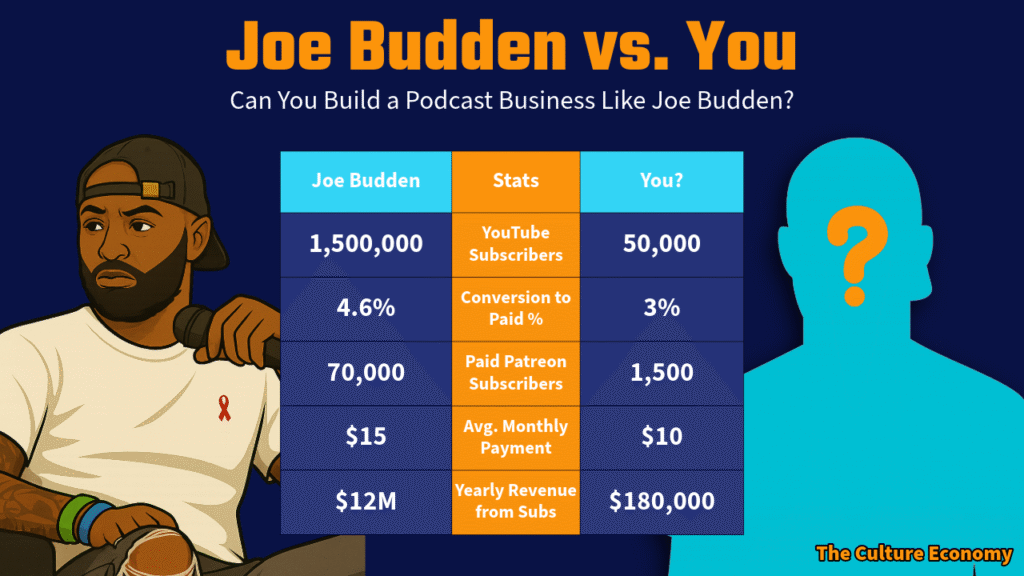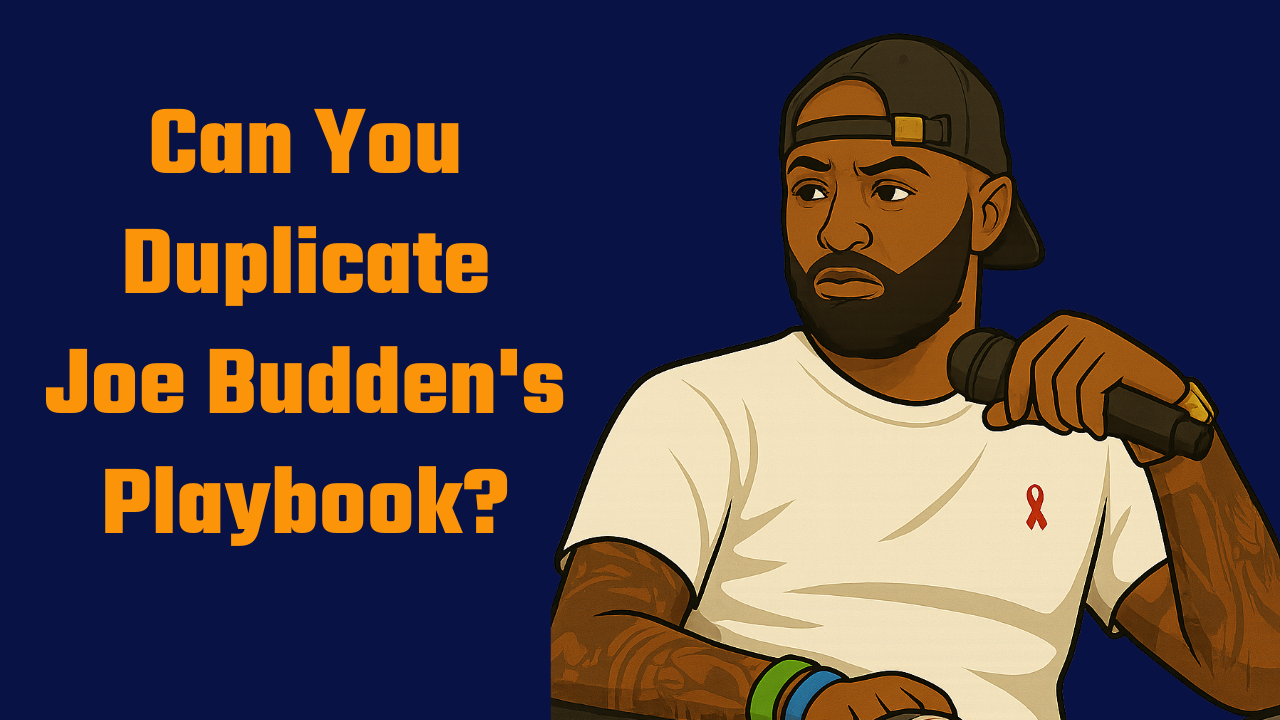Okay, folks! We’re back. I know I disappeared on you for a second, but I’m making this promise here today: you’re going to get four newsletters from me in August, even if I have to go sleepless trying.
So consider this the first of four.
The Context
A rapper with one mainstream hit 20 years ago now runs one of the most profitable independent media companies in hip-hop—and he’s done it without making a drop of new music.
According to The New York Times, Joe Budden (of “Pump It Up” fame) and his podcast network are projected to earn $20 million in 2025. Here’s how it breaks down:
- $1M per month ($12M/year) from Patreon subscriptions
- Another $8M/year from ads, merchandise, and partnerships
- Social reach: 1.5M on YouTube, 1.7M on IG, and 450K on TikTok
Patreon was happy to get this message out. Joe Budden didn’t hold back in sharing it. And the creator economy world was taken aback.
But should they have been?
The Connection
While the size of Budden’s success may shock you, it shouldn’t surprise you. We’ve been on this path for a long time.
Kevin Kelly is the author of the now-legendary blog post, “1,000 True Fans”. In it, he distills how the internet allows creators to make a living by having a direct relationship with their audience. Pre-internet, he argues, a death metal music band in a small town couldn’t make a living off the 2 people willing to come to their performances. But in the internet age, that band has a chance at finding the 1,000 people in the world willing to pay for that music. Kelly also notes that creators serving niche audiences have an advantage over big media, which is institutionally unable to find and deliver niche content.
And that article? It was published in March of 2008. Over 17 years ago! Yet, everything Keily wrote has become even more true today.
Joe Budden is proof of this—in a massive way.
Budden’s success shows you can make massive money without a massive audience. He has fewer than 3.7M followers across the three main social platforms. He’s not a top-charting podcast on Apple or Spotify. He only ranks #9,156 on FamousBirthdays.com—he’s not even among the Top 20 “Joes”!
And yet, he’s making $20M/year—more than many podcasts ahead of him in the charts, more than TikTokers with tens of millions of followers, and more than many of the other 27 Joes ranked ahead of him.
This illustrates the decline in importance of massive distribution (e.g., HBO) and the shift towards owned audiences. Yes, you need distribution to accrue an audience. But once you own your audience, the means to monetize it has no end.
Just knowing Budden is making $20M/year off 1.5M YouTube subscribers brings a tear to my eye.
Because doesn’t that mean 150K YouTube subs could gross $2M/year?
Could 15K gross $200K/year?
The numbers suggest it’s possible.
Then again, this isn’t just a numbers game. Budden’s financial ascent is also the product of culture:
The Two Cultural Drivers of Budden’s Success
Driver of Culture
- Budden’s show speaks directly to the issues his culture cares about, inside and outside of music. His background as a rapper gives him credibility. His consistency makes him an authority.
Countercultural Shift
- As trust in traditional media declines, Budden’s independence—and his legendary Spotify exit—position him as a credible voice bucking the system.
Strategic Elements
Then there are the strategy in all of this. First, Joe has leveraged several large platforms to boost his own:
- Jan 2013: Joined VH1’s Love & Hip-Hop
- May 2016: Released diss tracks aimed at Drake and Meek Mill
- Apr 2017: Joined Complex’s Everyday Struggle
- May 2018: Began hosting Revolt’s State of the Culture
- Aug 2018: Signed with Spotify
- Nov 2018: Returned to Love & Hip-Hop
- Feb 2021: Partnered with Patreon as Creator Equity Advisor
And that’s not inclusive of all the controversies, public spats, physical altercations, questionable decisions, and legal feuds with enemies, family, colleagues, public figures, and public companies.
Second, Budden has also been online for nearly two decades, as an early Twitter adopter and 18 years on YouTube. He knew the internet’s power early and learned how to manipulate it.
Lastly, Budden’s biggest strategic advantage may be something that doesn’t seem strategic or intentional: candor.
He has opened up about addiction, professional blow-ups, and unflattering opinions about the music industry’s biggest names. For a millionaire insider, that honesty makes him relatable.
When you put it all together, in Budden, we have someone dedicated to the culture, an insider raging against the machine, and a master at drawing attention to himself. If that combination of culture, strategy, and content sounds familiar, you may be thinking of someone currently residing in the White House.
The Contrast
That said, there are parts of Budden’s blueprint that can’t be replicated by most:
- A known name from music and reality TV
- A head start on YouTube, uploading podcasts before it was popular
- Comfort with controversy and blunt opinions; from BET Awards red carpet standoffs to public fights with public companies
But the core of his rise rests on three replicable pillars:
- Consistent Publishing – Since 2015, Budden has released episodes weekly (now multiple times a week), regardless of drama, controversy, or business negotiations.
- Eventual Multi-Platform Monetization – Patreon may deliver $12M/year, but ads, YouTube revenue, merch, and licensing add another $8M.
- Willingness to Experiment – He’s toured nationally, launched spin-off shows, tested different formats/hosts, and leveraged platforms strategically. The podcast itself started as an experiment.
The Calculation
As usual, I have to break down the numbers. So, here they are:
- Budden has 1.5M non-paying subs on YouTube
- Budden has 70,000 paying Patreon subscribers
- That means he has a 4.6% conv. rate from YouTube to Patreon
- Subs pay an average of ~$15/month, grossing Budden $12M/year
Now, let’s scale that down to something attainable for a hard-working, talented, community-building creator:
- You build up to 50,000 YouTube subs over 2-3 years
- You’re no Joe, so you only convert 3% to Patreon: 1,500 paid subs
- If you charge $10/month, you’d make $180,000 per year

The caveat: Culture.
Budden is not converting 4.6% of his audience into paid subscribers because he turns into Dr. Martin Luther King behind a podcast mic. No, he’s able to convert at a rate 5X what most creators are lucky to see (i.e., ~1%) because he’s culturally essential to his audience. When something happens in music or Black culture, his listeners need to hear his take.
So, if you want to push far above industry-average conversion rates, it’s your alignment with the culture that will allow you to do so.
The Conclusion
The internet focused on Budden’s $20M headline. But the real story is culture.
Yes, that headline number means a lot, and may even represent a watershed mark in the shift occurring in podcasting and the creator economy. And of course, Budden’s independent nature, which included keeping ownership of his podcast in the face of offers from giants like Spotify and amounts totaling $40M. People laughed at him for saying he thought he was more valuable than that. And now we all can see the value Budden saw in himself long ago.
But for me, this story is about the culture. How listener for listener, Budden is likely outpacing all of his peers, because he has the media’s one true force multiplier: cultural capital.
With that in, he’s been able to build a super-engaged community, one that shows up for him on YouTube, Twitter, Reddit, and live shows.
Thus, if you’re a creator, let these be the main takeaways you leave with:
- Identify the culture you serve – And serve it to no end. Not everyone has the talent or courage to do so. But if you have the culture behind you, everything else will fall into place.
- Build community in the right rooms – Budden didn’t go to Vice or Real Housewives to grow his audience, he went where hip-hop fans were: Complex, VH1, Revolt.
- Diversify early – Budden waited 6 years to adopt subscription revenue. Don’t wait that long. Test ads, merch, subscriptions, and events to see what works best for your audience.
Follow those three principles, adapt parts of the overall Budden playbook, and while you might not make $20M/year, you can make a living. And that would make Kevin Kelly a very proud—and very right—man.
